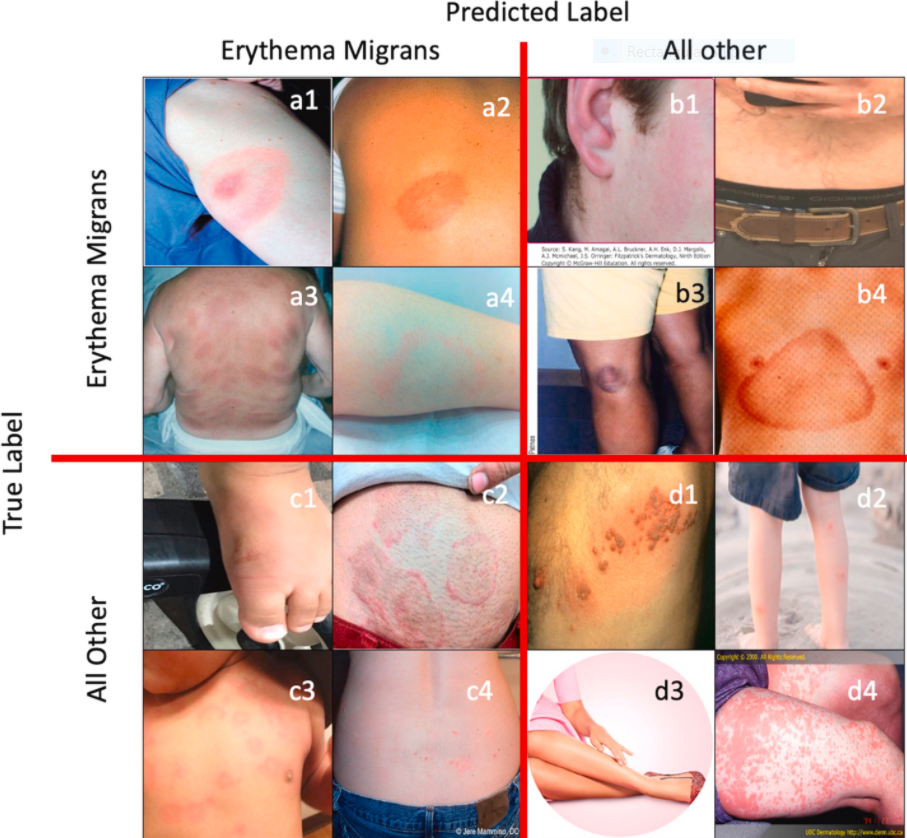Summary
This study shows that artificial intelligence (AI) and deep learning (DL) methods can be used to analyze cell phone rash images to more accurately detect and prescreen the erythema migrans (EM) rash of acute Lyme disease. Accurate identification of a Lyme disease rash using an AI and DL evaluation of digital photos can enable more reliable early diagnosis and treatment and potentially help avoid later neurologic, rheumatologic, and cardiac complications of Lyme disease.
Why was this study done?
There are over 300,000 new cases of Lyme disease in the US annually and many cases are misdiagnosed. Lyme disease is especially difficult to diagnose early when treatments are most effective. Blood tests are antibody-based and unreliable, especially in acute illness. Direct tests of the pathogen Borrelia burgdorferi by culture, PCR of blood, or skin biopsy are problematic and not generally available to clinicians. The rash, when present, has varied presentations that can be confused with other illnesses. The goal of the research is to explore whether AI and DL can help improve the accuracy of Lyme disease rash recognition and early diagnosis.
How was this study done?
The Johns Hopkins University Applied Physics Lab (APL) developed and tested several deep learning models for detecting erythema migrans versus other clinically relevant skin conditions as well as normal skin. The DL models were trained on a combination of images available online in the public domain as well as clinical images of well-documented patients with EM digital photos provided by the Johns Hopkins University Lyme Disease Research Center and Lyme Disease Biobank. APL employed a customized deep learning approach via deep convolutional neural networks (DCNNs) to classify, train, and optimize the rash photo data.
What were the major findings?
On public domain images, the DL system had an accuracy ranging from 71.58%, when classifying EM versus other skin pathologies, to 94.23% when comparing EM to normal skin. On clinical images of affected individuals, the DL system had a sensitivity of 88.55%.
These results suggest that the DL system can improve the accuracy of recognizing an EM rash compared with other clinically relevant rashes and help in prescreening and referring individuals to physicians for earlier diagnosis and treatment thereby potentially reducing further complications and illness.

What is the impact of this work?
Lyme disease misdiagnosis is common due to unreliable diagnostics as well as errors in rash recognition. This study’s AI and DL approach shows promise as a prescreening digital tool to improve the early recognition and diagnosis of a Lyme disease EM rash. This method has the potential to prompt patients to see a physician earlier for acute illness evaluation, diagnosis, and treatment and thereby may help avoid long-term multisystem complications resulting from late stage disease.
This research was supported by
The Lyme Disease Research Foundation, the Johns Hopkins University Applied Physics Laboratory Research and Development Funds and the Johns Hopkins Institute for Assured Autonomy. We thank Dr. Elizabeth Horn from the Lyme Disease Biobank for the procurement of additional EM images and Cheryl Novak for assistance with annotation of images.
Publication Information
AI-based detection of erythema migrans and disambiguation against other skin lesions. Computers in Biology and Medicine, Volume 125, October 2020, 103977, Philippe M.Burlinaab, Neil J.Joshia, Phil A.Mathew, WilliamPaula, Alison W.Rebman, John N.Aucott


